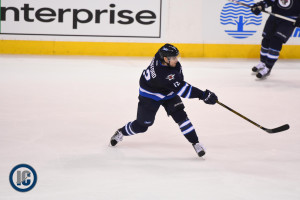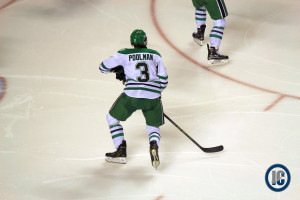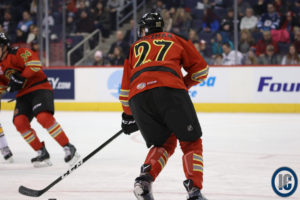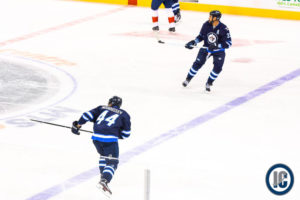Who’s on the Trading Block
The Jets have a few players who might draw some interest at Wednesday’s trade deadline. In the UFA group, we have Drew Stafford, Chris Thorburn, Paul Postma, and Ondrej Pavelec. The only one that’s seems likely to go is Stafford – a former top-6 winger who has been slowed by a combination of injuries and father time. Stafford could still provide scoring depth for a contending team, but the 31 year old has just 4 goals on the season, and a $4.3M salary, so it’s hard to imagine that he fetches more than a mid-round pick. (Anything beyond a 4th rounder should be considered a good haul).

A team looking for size and toughness might take a flyer on Thorburn for a late pick, while defenceman Paul Postma probably isn’t going anywhere with current Jets’ blueliners Toby Enstrom and Tyler Myers out with injuries. As for Ondrej Pavelec, if the market for Ben Bishop was that shallow, it’s hard to imagine teams will offer much of value for Pavelec.
In terms of non-UFA’s, many have speculated on the availability of versatile forward Mathieu Perreault – a player who struggled in the early part of this season, but has come on of late playing on a line with Mark Scheifele and Patrik Laine. Due to the pending expansion draft, some think the Jets would be wise to trade Perreault rather than potentially lose him for nothing in June. However, with four years left on his next contract (he signed an extension last summer), the number of teams interested in trading for him would probably be small. Barring a big surprise, the only other player who could go at the deadline is Shawn Matthias – a big, bottom-6 winger with decent finishing ability, he could be a good depth player for a playoff run, and also help satisfy a team’s expansion requirement this June. Each team needs to expose at least 2 forwards, 1 defenceman, and 1 goaltender, all of whom have more than 2 years of NHL experience and are currently under contract (except goaltenders, who can simply be Restricted Free Agents; other complexities may apply, here are the official rules).
The Jets’ Biggest Organizational Need
Everyone knows the Jets need a starting goaltender. Most people agree that Connor Hellebuyck is still a very good prospect, who deserves to play in the NHL, just not as the clear starter. They need to add a goalie who can play 35-45 games, give them quality starts, and take the pressure off Hellebuyck while making him earn the starter’s role. The Jets also need to improve their 27th ranked PK – some say a penalty-killing forward is key here – as well as their 20th ranked powerplay (side note: how does Laine’s shot not have that solved yet?). The thing is, none of these issues are the biggest organizational need, or the toughest to solve. The goaltending issues can be solved quickly and fairly easily this off-season – Bishop, Miller, Elliot, Johnson, Neuvirth, Mason, Darling, Nilsson and Kuemper are all UFA’s, while Fleury, Halak, Howard, and Raanta could all be had in trades. Surely, one of those players can be part of a decent tandem that will bring the Jets’ goaltending up to an average level, and outside of Bishop and Fleury, most of the salary/trade demands won’t be audacious. Penalty killing forwards are relatively easy to acquire – look no further than 4th line centre, Jay McClement who leads Carolina’s #1 ranked pk in time-on-ice among forwards, made $1.1M this year, and is a free agent. As for the PP, all the pieces are already there in-house – Laine, Scheifele, Ehlers, Petan, Morrissey, etc. Just give it time.
The issue that requires the most organizational focus both now, and for the next 2-3 years, is the defence. When healthy, the Jets’ current defensive group looks great on paper – Byfuglien, Trouba, Enstrom, Myers and Morrissey are a very skilled group, all between the ages of 21 and 32; three of them are right-handed, two of them are over 6’4, and all of them skate well. Most GM’s would kill for that balance and skill. Here’s the rub – Enstrom turns 33 this year, and only has one year left on his deal; Myers has missed most of this season, and his 6’8 frame may have a chronic “lower-body” issue; Byfuglien is in his 30’s, and has been putting a ton of miles on his 250+ lb. body all season, leading the NHL in time-on-ice per game; Josh Morrissey is exceeding expectations, but he’s still just a 21-year-old rookie, and Jacob Trouba – good as he is, and great as he can be, could re-ignite that trade request at a moment’s notice. And who do the Jets have coming to the lineup in the next year or two to fill some of these top-4 spots? As of right now the answer is nobody. Logan Stanley may or may not develop into a top-4 d-man one day, but the Jets themselves have said publicly that it won’t be happening in the near future. (Think 2-4 years down the road). Sami Niku is a promising late-round pick out of Finland, but he’s just 20, slight, and may not have high-end potential. And Tucker Poolman has everyone in a tizzy about whether or not he’ll sign with the Jets or Vesey his rights away, but unless he’s that rare late bloomer, this 23-year-old NCAA prospect may not become more than a 3rd pairing d-man. (Facing 18-22 year old’s each game as a 6’3, 210 lb., 23-year-old d-man is a classic big fish, small pond scenario. Couple that with playing on perennial powerhouse UND, you need to take his 23 points in 32 games with a grain of salt).

While the Jets have forward prospects a plenty – Connor, Roslovic, Foley, Spacek, Harkins, et al – and good young goaltenders in Hellebuyck and Comrie – the defensive pipeline has been closer to a trickle by comparison. Certainly, the Jets have done well in the first round, getting Jacob Trouba in 2012, and Josh Morrissey in 2013, but the organization hasn’t had nearly the same level of success when it comes to drafting d-men in the middle and later rounds, with notable misses on:
2011 – Brennan Serville and Zach Yuen – doubtful that either will ever play a single game in the NHL (both are gone from the organization)
2013 – Jan Kostalek, Brendan Kichton, and Marcus Karlstrom – Kostalek is currently a bottom pairing guy with the Moose who has some ability but isn’t trending well; Kichton is 24 and is probably a minor-leaguer for life, and Karlstrom – 21 – doesn’t play pro hockey, or in a recognized developmental league
2014 – Jack Glover and Nelson Nogier – the former, a frequent healthy scratch at the University of Minnesota; the latter, more likely to be a depth option due to limited offensive upside.
So beyond the aforementioned Niku (drafted 2015), Tucker Poolman (2013), and Logan Stanley (18th overall in 2016), the tap is dry. To make matters worse, the Moose haven’t been able to bring in any good experienced AHL defencemen, college free agents, or European free agents to fill the void. Last year, veteran blueliner Jay Harrison (372 NHL games) was expected to anchor the Moose defence, but he missed most of the year due to injury; veteran AHL defenceman Andrew MacWilliam was also brought in for 2015-2016 to help provide a veteran presence in the top-4, but he lacked the puck-moving ability and hockey sense to be a capable top-4 AHL defender. This season, former New York Islander Brian Strait (182 NHL games) was brought in to be the Jets’ 1st call up – the “8th defenceman” – but he’s been no better than MacWilliam, and is consistently one of the most error-prone defenders on the Moose. Kevin Czuczman and Peter Stoykewych have both been pretty reliable for the Moose this season, but both are in their mid-20’s, and signed to AHL-only contracts.

Contrary to what you might think, the biggest concern here isn’t the fact that the Jets organizational depth is shallow on defence but the manner in which the Jets organization evaluates defencemen. The trend is clear – too often, the Jets prize physical traits – size and skating – over skill/hockey sense. Since they returned in 2011, they have drafted 1 defenceman under 6 feet – that was Brenden Kichton, who was taken in the 7th round in 2013 – a late round flyer on a 5’10 guy who lit up the WHL offensively. Meanwhile, In the 3rd and 4th rounds, the Jets have liked several players who stood 6’3 or greater and could move their feet – Brennan Serville, Jack Glover, Nelson Nogier, and Jacob Cederholm. All of those players had known offensive limitations on draft day, and unfortunately none of them have upped their stock since being drafted. The one bright spot could be Luke Green – a 3rd round pick in 2016 who plays an up-tempo, offence-first style of game. If you go a step further, this trend is even more clear with the veterans they’ve chosen to play top-pairing roles on the Moose in the past two years. No one has ever accused Julian Melchiori, Jay Harrison, Andrew MacWilliam, or Brian Strait of having above average skill, vision, or hockey sense. And yet these are the veterans who have lead the Moose back-ends over the past two seasons, leading the team to a 30th place finish in 2015-16, and perhaps another bottom-5 finish this season. Is it any wonder that Moose have struggled to score for the past two years? Their top-pairing defencemen don’t move the puck well, aren’t mobile, and are below-average shooters. It’s a trend that needs to end immediately, before it’s too late.
Here’s the reality – it may already be too late for the Jets to start drafting defencemen who will join the core of Scheifele, Laine, Ehlers, Trouba (?), Morrissey, Hellebuyck, and the like. It’s certainly too late for them to join Wheeler and Little in their prime years. Outside of a top-5 pick, most of the defencemen drafted in 2017 will need 4-6 years before they start making really meaningful contributions in an NHL team’s top-4. That doesn’t mean that a Cal Foote or a Nic Hague – potential top-10 picks in this year’s draft – can’t be playing regular NHL minutes in 2 years, but for them to be playing big minutes in a playoff run in the near future is asking way too much. If we assume that’s true, that only leaves two other options: trades, and free agency. On the trade front, the Hall-Larsson deal already told a cautionary tale for the league’s 28 other GM’s, and put millions of armchair GM’s into full cardiac arrest. A first line, potentially elite winger, was traded straight up for a #4 defenceman with limited offensive ability. If the Jets went this route, trading a young forward like Ehlers for a top-4D, you can bet that Twitter in Manitoba would shut down for the day, maybe the week. No, when you talk about trading for a defenceman, you need to buy low – perhaps a former first round pick who hasn’t carved out a full-time spot – say, Jamie Oleksiak in Dallas, or Ryan Murphy in Carolina. Specific players aside, it should be someone who won’t cost you a lot, who may still have some upside, and ideally, who craves a change of scenery.
You need to employ the same basic strategy when considering UFA’s. Don’t bother chasing the Alzner’s and Shattenkirk’s of the world, who likely aren’t interested in coming here – at 27 going on 28, their best years are soon to be behind them, but their huge salaries will follow them to age 35! Look at players like Michael Del Zotto, Brendan Smith, Kyle Quincey, or Patrick Wiercioch – guys who have been effective in the past, or who showed some promise, and could prove to be very good third pairing guys for the next few years. Search deeper in the bargain bin and find a player like Matt Irwin – a former “high-end” AHL d-man with some NHL experience, seemingly overlooked by everyone, who signed near the league minimum. He’s quietly playing a nice depth role in Nashville for 575k – 25k less than Brian Strait. He’s the type of player who, if nothing else, can help bridge the gap for your prospects.
The other place the Jets need to mine defensive talent (arguably, all talent), is in their scouting of College and European free agents. You like top-pairing d-man Nikita Zaitsev in Toronto? Bet you like him even more when you hear he cost them nothing. No trade or no draft pick surrended – and like all rookies, on an entry-level contract! (Albeit for 1 year only.) Convincing the Russians to come over is the tougher part, but there may be a few more to be had, especially if concerns over the KHL’s financial sustainability continue. The NCAA has also provided some immediate help for a few Canadian clubs – Troy Stecher (North Dakota – Vancouver) has been great, while Matt Benning (Northeastern- Edmonton) has fit in nicely too. Michal Kempny (KHL – Chi), Yohann Auvitu (SM-Liiga, New Jersey), and Tim Heed (SHL – San Jose), were some other recent, undrafted or previously unsigned players that have provided their NHL clubs with the type of quality, affordable depth that the Jets have been sorely missing in the past few years.
In sum, the Jets have dug themselves a defensive hole which, in just 18 months, could mean this roster goes from:
Morrissey-Trouba Morrissey-Byfuglien
Enstrom-Byfuglien TO: ? – ?
_______-Myers ? – ?

True North would be well advised to make as many as four moves this offseason, rebuilding both the NHL bottom-pairing and the Moose top-pairing. Not only will this clearly make each team better, but it will help insulate and develop the likes of Tucker Poolman and Sami Niku as they (hopefully) enter the organization this spring, and take the time they need to adjust to a higher level of play this fall, (and – in Niku’s case – fill out). To appreciate how important it is to surround young defencemen with capable partners, look no further than the path of Josh Morrissey: he got his first taste of pro hockey as an 18-year-old, in the 2014 AHL playoffs. He impressed so much that he ended up playing top-4 minutes, putting up 9 points in 20 games as the St. John’s Ice Caps went all the way to the Calder Cup Final. The rest of the top-4 included future NHL’ers Zach Redmond and Ben Chiarot, and quality AHL veteran Will O’Neill. The team also featured another rookie, 21-year-old Brenden Kichton, who fit in so well on in that defensive group that he put up 48 points in the regular season and was named an AHL all-star (although Morrissey pushed Kichton down the lineup in the playoff run). By contrast, the next time Jets fans heard from Morrissey in a pro uni, it was in his Moose debut in 2015-2016. Morrissey started last season with 2 points in his first 22 games. Is it a coincidence that in that brutally underwhelming stretch, Morrissey was basically asked to be the Moose’s #1 defenceman? Even as a first round pick – 13th overall in 2013 – he needed more help. They all do.



